VOLKSWAGEN GOLF 1993 1H / 3.G Owners Manual
Manufacturer: VOLKSWAGEN, Model Year: 1993, Model line: GOLF, Model: VOLKSWAGEN GOLF 1993 1H / 3.GPages: 156, PDF Size: 6.36 MB
Page 131 of 156

Downloaded from www.Manualslib.com manuals search engine DO-lT-YOURSELF
Tow startingfTowing
Front towing eye
(Left-hand illustration)
To be able to tow the vehicle, a towing eye
must be screwed into front bumper on
right. The towing eye is in the vehicle tools .
•
Lever cover out forwards with flat blade
of screwdri ver (fro m vehicle tools) and remove -see also page 124.
• The towing eye has a left- hand thread . ~crew to~ing eye in onto stop and tighten with wheel spanner -see illustration.
• . After use unscrew towing eye and place with vehicle tools. The towing eye must always be carried in the vehicle_ Refit
cove r -see page 123.
Rear towing eye
(Right-hand illustration)
The rear
towing eye is located on the right In the bumper and is covered by a cap. To
open, unclip ca p, first at the top, then at the
botto m and leave it hanging To close flap, lit bottom first and then push upwa rds unti l It engages .
General notes
Tow-ropes or bars should be atta ch ed at
these points only.
• The tow- rope
should be slight ly elastic to
reduce the risk of damage to both vehicles .
It IS advi sable to use synthe tic fibre ropes ,
or ropes of Similar elastic materia l.
Avoid excessive towing effort and do not
Jerk. DUring tow ing opera tions on other than
surfaced roads there is always the danger
that the attachment points will be over
loaded and damaged.
• Before trying to start engine by t?wing, the battery from another vehicle. should be used for starting if possible -see previous page.
If the vehicle has to be tow started
or towed at any time, the following
must be noted: .
• Check whethe r there are any local traffic regulat ions concerning the towing of ve
hicles .
• Both drivers
must be familiar with towIng procedures. Inexperienced drivers
should not attempt to tow start or tow.
• When using a to w-rope the driver of the
towing vehicle must engage the clutc h very
gent ly
v,/hen moving off and changing gear.
• The driver of the veh ic le being
towed must ensure that the tow -rope is always ta ut.
129
Page 132 of 156
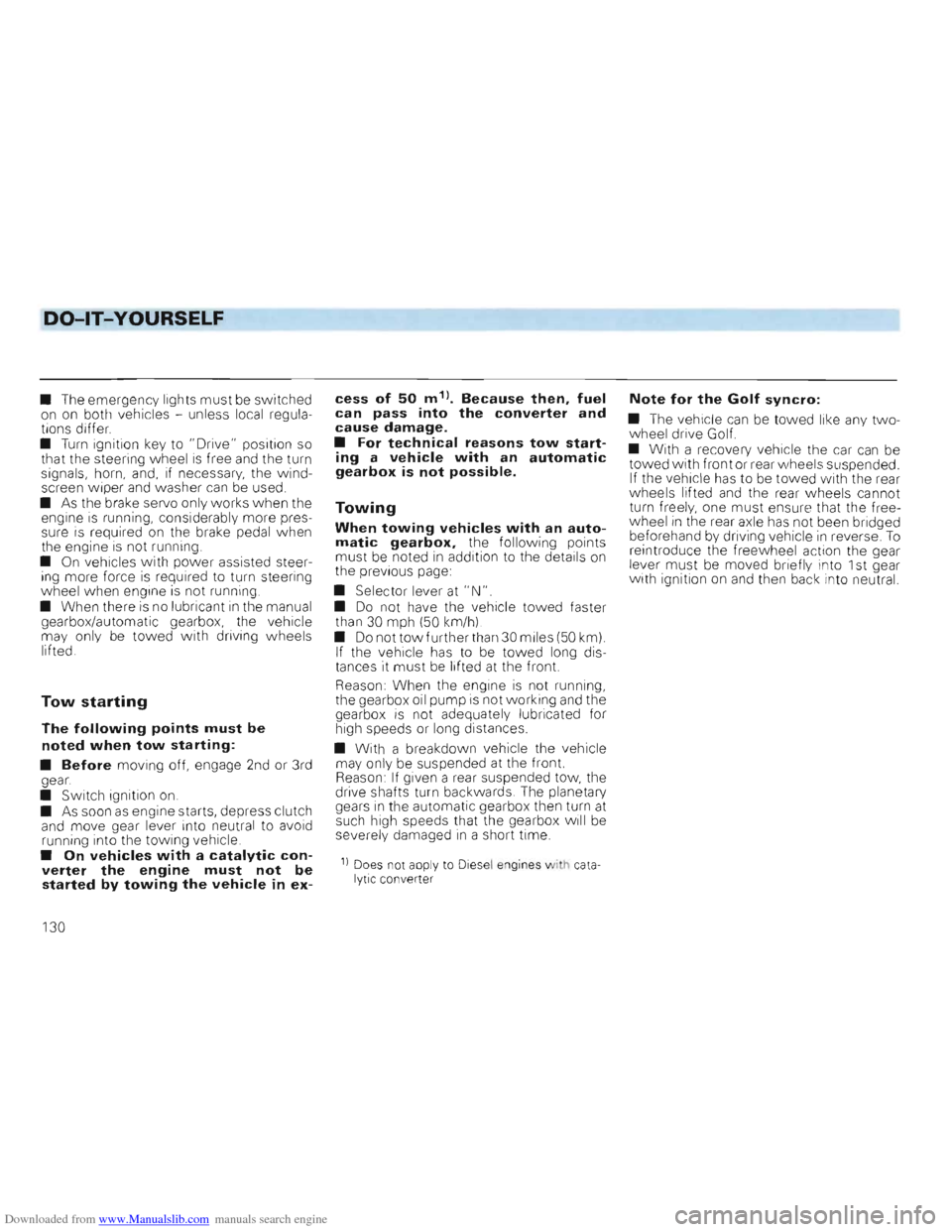
Downloaded from www.Manualslib.com manuals search engine DO-lT-YOURSELF
• The emergency lights must be switched
on on both vehicles -unless local regula
tions differ.
•
Turn ignition key to "Drive" position so that the steering wheel is free and the turn
signals, horn, and, if necessary, the wind
screen wiper and washer can be used.
•
As the brake servo only works when the
engine is running, considerab ly more pres
sure is required on the brake pedal when
the engine is not running
•
On vehicles with power assisted steer
ing more force is required to turn steering
wheel when engine is not running.
• When there
is no lubricant in the manual
gearbox/automatic gearbox, the vehicle
may
on l y be towed with driving wheels
lifted.
Tow starting
The following points must be
noted when tow starting:
• Before moving off, engage 2nd or 3rd
gear .
• Switc h ignition
on. • As soon as engine starts, depress clutch and move gear lever into neutral to avoid
running into the towing vehicle.
• On vehicles with a catalytic converter the engine must not be started by towing the vehicle in ex
cess of 50 mll. Because then, fuel can pass into the converter and cause damage.
• For technical reasons tow starting a vehicle with an automatic gearbox is not possible.
Towing
When towing vehicles with an automatic gearbox, the following points
must be noted in addition to the details on the previous page :
• Selector lever
at " N". • Do not have the vehicle towed faste r
than 30 mph (50 km/h)
• Do not
tow further than 30 miles (50 km).
If the vehicle has to be towed long dis
tances it mu st be lifted at the front.
Reason: When the engine
is not running ,
the gearbox oi l pump is not working and the
gearbox is not adequately lubricated fo r
high speeds or long distances .
• With a breakdown vehicle the vehicle
may only be suspended at the front.
Reason: If given a rear suspended tow, the
drive shafts turn backwards . The plane tary
gears
in the automatic gearbox then turn at
such high speeds that the gearbox will be severely damaged in a short time .
1) Does not apply to Diese l e ng ines wi h cata
lytic conve rter
Note for the Golf syncro:
• The veh icle can be towed like any two
wheel drive Golf.
• With a recovery vehicle the car
can be
towed with front or rear wheels suspended.
If the vehicle has to be towed with the rear
wheels lifted and the rear wheels cannot
turn freely, one must ensure that the free
wheel
in the rear axle has not been bridged
beforehand by driving vehicle in reverse. To reintroduce the freewheel action the gear
lever must be moved briefly in to 1 st gear
wi th ignition on and then back in to neutral.
1 30
Page 133 of 156
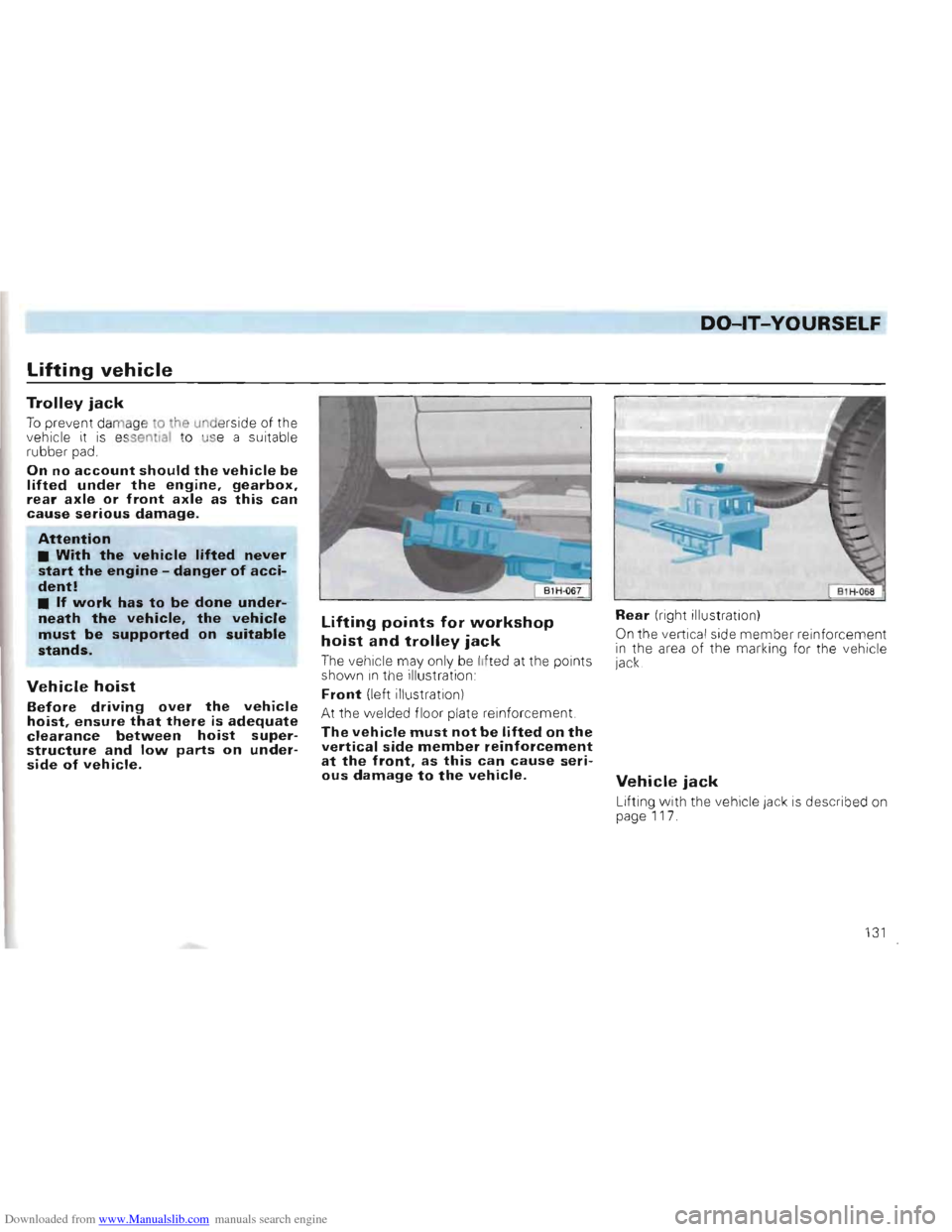
Downloaded from www.Manualslib.com manuals search engine Lifting vehicle
Trolley jack
To prevent damag e to the underside of the
vehicle it is essential 0 us e a sUitable
rubbe r pad
On no account should the vehicle be lifted under the engine, ge~rbox, rear axle or front axle as thIs can cause serious damage.
Attention
• With the vehicle lifted neve.r start the engine -danger of accIdent! • If work has to be done underneath the vehicle, the vehicle must be supported on suitable stands.
Vehicle hoist
Before driving over the vehicle hoist, ensure that there i:; adequate clearance between hOIst superstructure and low parts on underside of vehicle.
Lifting points for workshop
hoist and trolley jack
The vehic le may only be lifted at the points
shown in the illustration:
Front (left illustration)
At the welded floor plate reinforcement.
The vehicle must not be lifted on the vertical side member reinforcemen.t at the front, as this ca~ cause serious damage to the vehIcle.
DO-lT-YOURSELF
Rear (right illustration)
On the verti cal side member reinforcement
i n the area of the marking for the vehicle
jack
Vehicle jack
Lifting with the veh icle jack is described on pagel17 .
131
Page 134 of 156
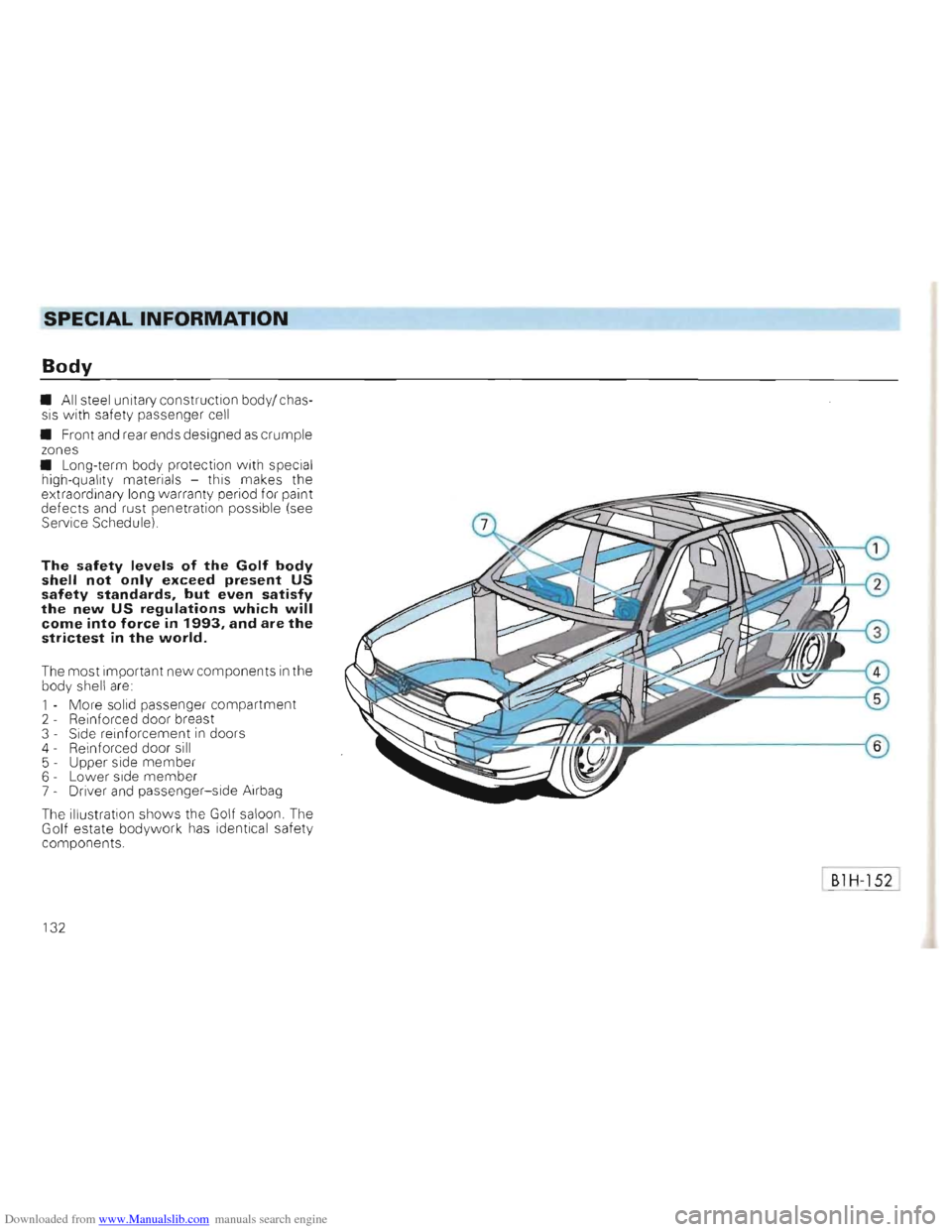
Downloaded from www.Manualslib.com manuals search engine ---------------------------------SPECIAL INFORMATION
Body
• All steel unitary construction body/ chas
sis w ith safety passenger cell
• Front and rear ends des igned as crumple
zones
• Long -
term body protecti on with special
high-quality materials - this makes the
extraordinary long
warranty period for paint defects and rust penetration possible (see
Service Schedule)
The safety levels of the Golf body shell not only exceed present US safety standards, but even satisfy the new US regulations which will come into force in 1993, and are the strictest in the world_
The most important new components in the body shell are
1 -
More solid passenger compartment 2 - Reinforced door breast
3 - Side reinforcement in doors
4 - Reinfor ced door sill
5 - Upper side
member 6 -Lower Side member 7 - Driver and passenger-side Airbag
The illustration
shows the Golf saloon . The
Golf estate bodywork has identical safety components.
I B1H-152 ;
132
Page 135 of 156
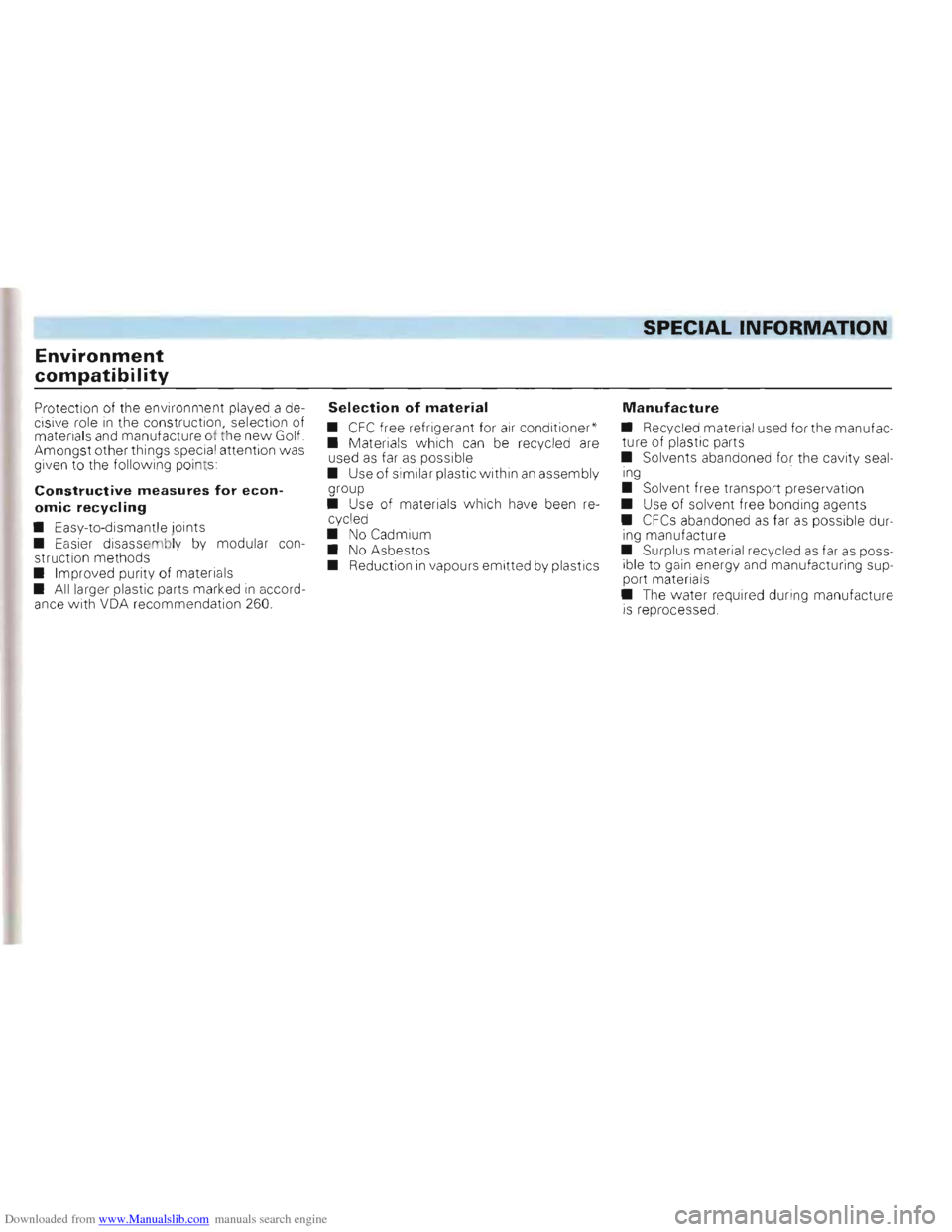
Downloaded from www.Manualslib.com manuals search engine SPECIAL INFORMATION
Environment
compatibility
Protection of the enviro nment played a de
cisive role in the construction, selection of
materials and manufacture ot the new Golf.
Amongst other things special attention was
given to the following
POI ts
Constructive measures for econ
omic recycling
• Easy-to-dismantle Joints
• Easier disassembly by modular con
struction methods
• Impro ved purity of materia
ls • All larger plastic parts marked in accord
ance with VDA recommend ation 260.
Selection of material
• CFC free refrigerant for air conditioner*
• Materials which
can be recycled are
used as far as possible
• Use of similar plastic within
an assembly
group
• Use of materials which have been
recycled
•
No Cadmium
• No Asbestos
• Reduction in vapours emitted by plastics
Manufacture
• Recycled material used for the manufac
ture of plastic parts
• Solvents aban doned for the cavity seal
ing
• Solvent free transport preservation
• Use of solvent free bonding agents
•
CFCs abandoned as far as poss ible dur
ing manuf acture
• Surplus material recycl
ed as far as poss
ible to gain energy and manufacturing sup
port mate rials
• The
water requ ired during manufacture is reprocessed.
Page 136 of 156
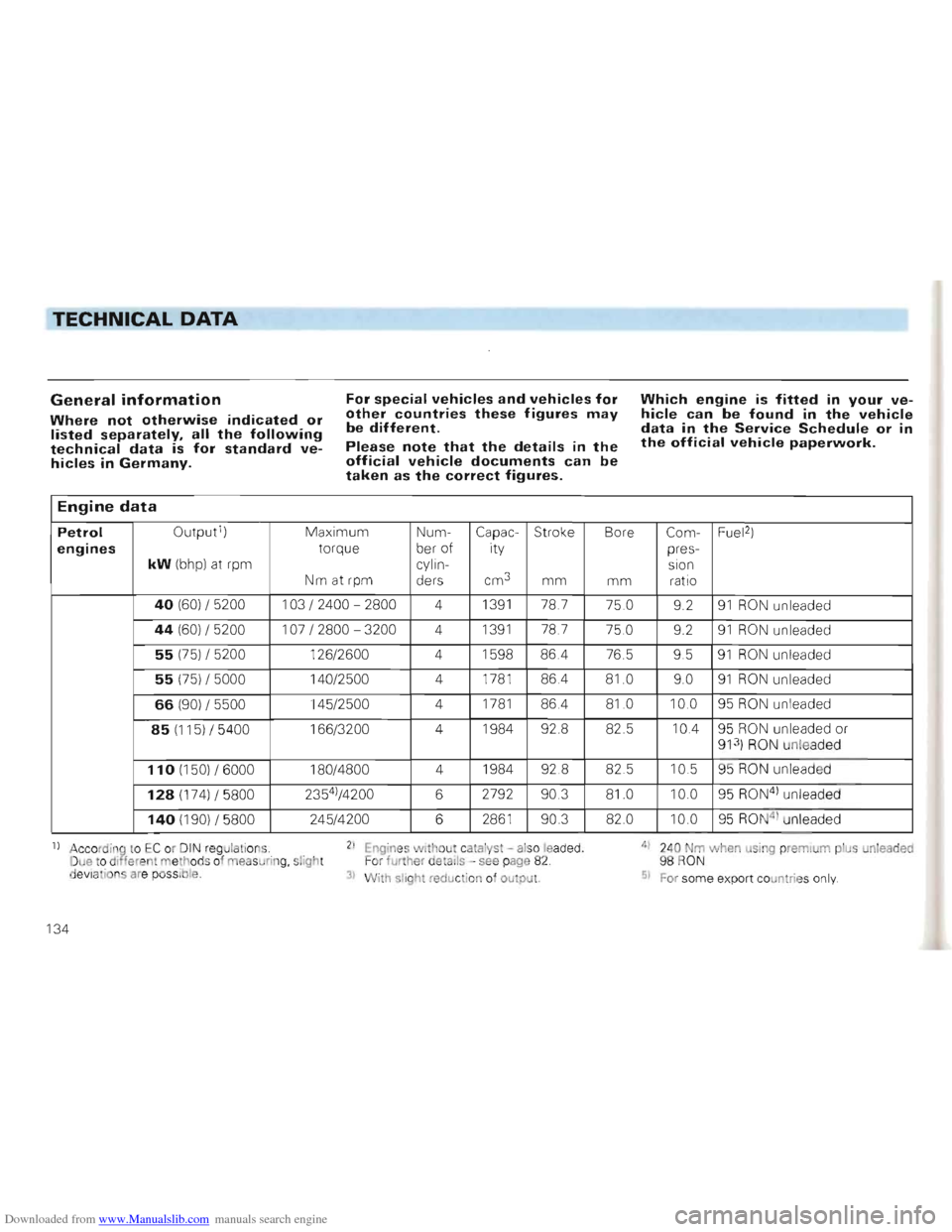
Downloaded from www.Manualslib.com manuals search engine TECHNICAL DATA
General information
Where not otherwise indicated or listed separately, all the following technical data is for standard vehicles in Germany.
For special vehicles and vehicles for Which engine is f itted in your veother countries these figures may hicle can be found in the vehicle be different. data in the Service Schedule or in the official vehicle paperw ork.Please note that the details in the official vehicle documents can be taken as the correct figures.
Engine data
Petrol
engines
Output1
)
kW (bhp) at rpm
Maximum
torque
Nm at rpm Num
ber of
cylin
der s Capac
-
ity cm3
Stroke
mm
Bore
mm
Com pres
sion
ratio Fuel 2
)
40 (60) / 5200 103 / 2400 -2800
4 1
39 1
78.7 75 .0
9.2 91 RON un leaded
44 (60) / 5200 107 / 2800 -3200
4 1391 78.7
75.0
9.2 91 RON un leaded
55 (75) /5200 126/260 0 4 1598
86.4 76.5
9.5 91 RON unleaded
55 (75) / 5000 140/2500 4 1781 86.4 81.0
9.0 91 RON unleaded
66 (90) / 5500 145/2500
4 1781 86.4 81.0 100 95 RON unl
eaded
85 (115) / 5400 1
66 /3200 4 1984
92.8 82.5 10.4
95 RON unleaded or 91 3
) RON un leaded
110 (150) / 6000 180/4800 4 1984
92 .8 82.5 10
.5
95 RON unleaded
128 (174) / 5800 2354)/4200
6 2792
90.3 81.0 100 95 RON4 ) u nleaded
140 (190) / 5800 245/4200 6 286
1 90.3 82.0 10.0 95 RON4) unleade d
1) Acco rding to E C o( DI N regulati ons. 2
1 Engin es witho ut catalyst -also leaded, 41 240 Nm when using premium plus nleaded Due to diff ere nt eth ods of measuring, slight For furthe r deta ils -see page 82. 98 RON devlatio s ar e pOSSible . 3) With slight reductio n of output. 51 For some export countrie s only.
134
Page 137 of 156
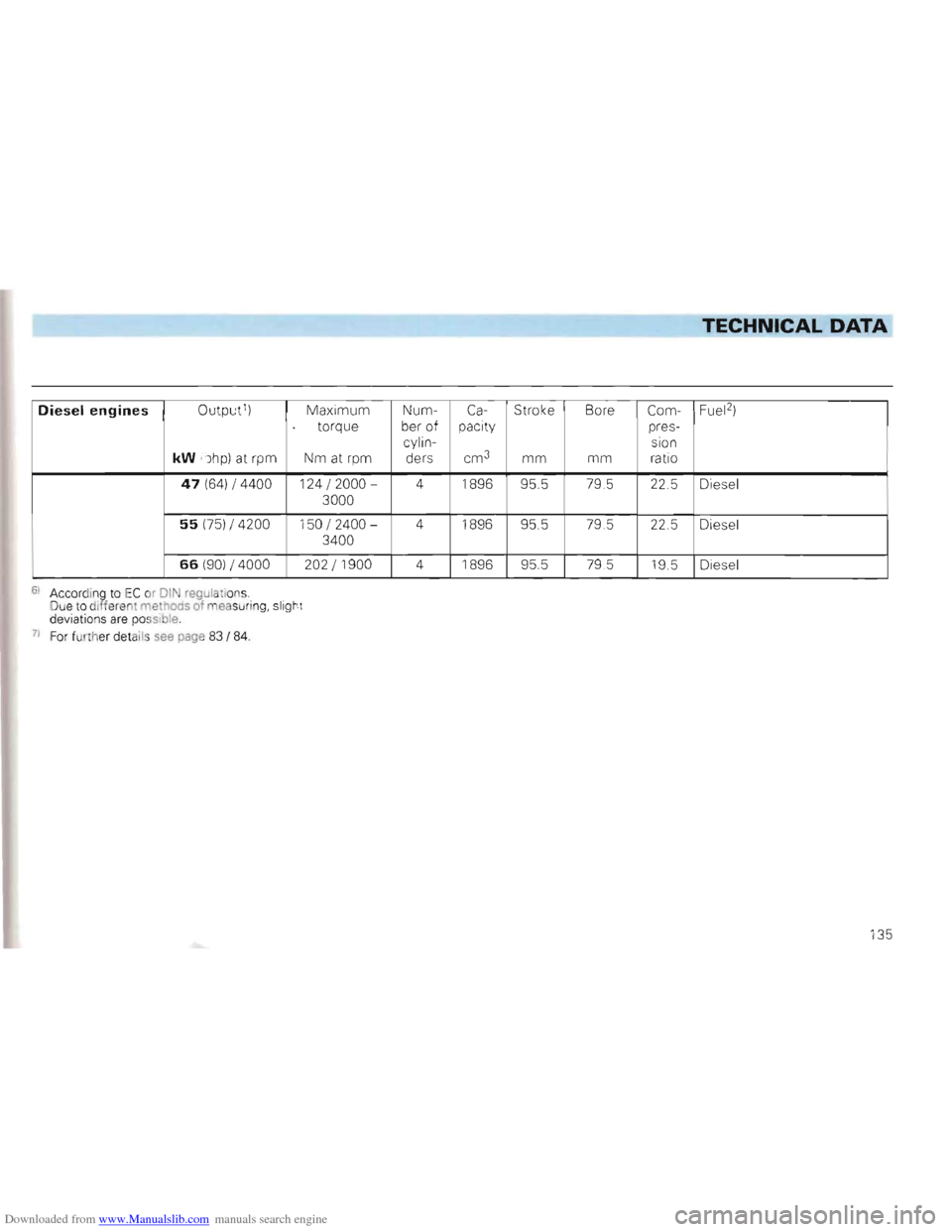
Downloaded from www.Manualslib.com manuals search engine ----------------------------------------------------------------TECHNICAL DATA
Diesel engines Output1)
kW (bhp) at rpm
Maximum torq ue
Nm at rp m N
um
be r of cyli n
de rs
Ca -
paci ty
c m
3
Stro ke
m m Bor
e
m m
Co m
p res
sion
r atio F
ue l
2
)
47 (64 ) / 44 00 124 /2000
30 00 4 1
89 6 95. 5 79.5 22.5
Dies el
55 (75) / 4200
150 /2400 -
3 4 00 4
1896 95. 5 79.
5 22. 5 Di ese l
66 (90) / 4 000 202/ 1900 4 1896
95.5 79 .5 19.5 Diesel
6) Accord ing to EC or DIN regul ati o ns .
D e to diff erent methods of mea suring, slight deviations are possible.
71 For furth er det ails see page 83 184.
135
Page 138 of 156
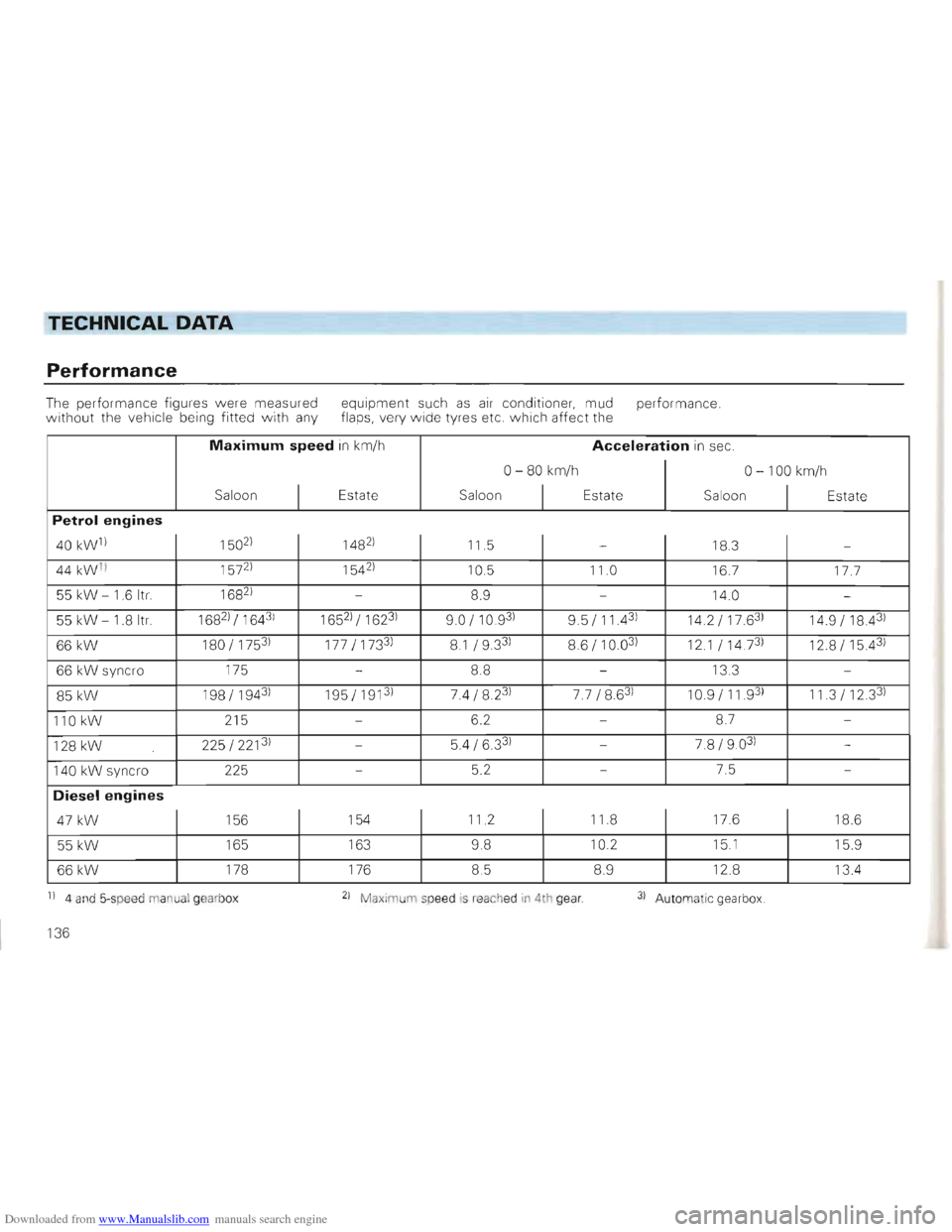
Downloaded from www.Manualslib.com manuals search engine TECHNICAL DATA
Performance
The performance figures were measured equipment such as air conditioner, mud
performance. without the vehicle being fitted with any flaps, very wide tyres etc. which affect the
Maximum speed In km/h
Saloon
I Estate
Acceleration in sec.
0-80 km/h 0-100 km/h
Saloon
I Estate Saloon I Estate
Petrol engines
40 kWl) 1502
) 1482
) 11.5 -18.3 -
44 kW I) 1572 ) 1542
) 10.5 11.0 16.7
17.7
55
kW 1.6 Itr. 1682
) -8.9 -14.0 -
55 kW 1.8 Itr. 1682
) /1643 1 1652
) / 16231 9.0/1093) 9.5/11431 142/17631 149/1843)
66
kW 180/17531 177 / 173 3
) 8.1/9.331 8.6/1003
) 12.1/1473) 12.8/1543)
66
kW syncro 175 -8.8 -13.3 -
85 kW 198/1943
) 195/191 3) 74/823 ) 7.7/8.63) 10.9/11931 11.3/ 12.331
110 kW 215 -6.2 -8.7 -
128 kW 225/221 3
) -54/6.331 -7.8/903) -
140 kW syncro 225 -5.2 -7.5 -
Diesel engines
47 kW 156 154
11.2 11.8 17.6 18.6
55
kW 165 163
9.8 10.2 15.1 15.9
66
kW 178 176 8.5
8.9 12.8 134
1) 4
and 5-speed manual gearb ox 21 M axim um s peed IS reached in 4th gear. 31 Auto mati c gearbox.
136
Page 139 of 156
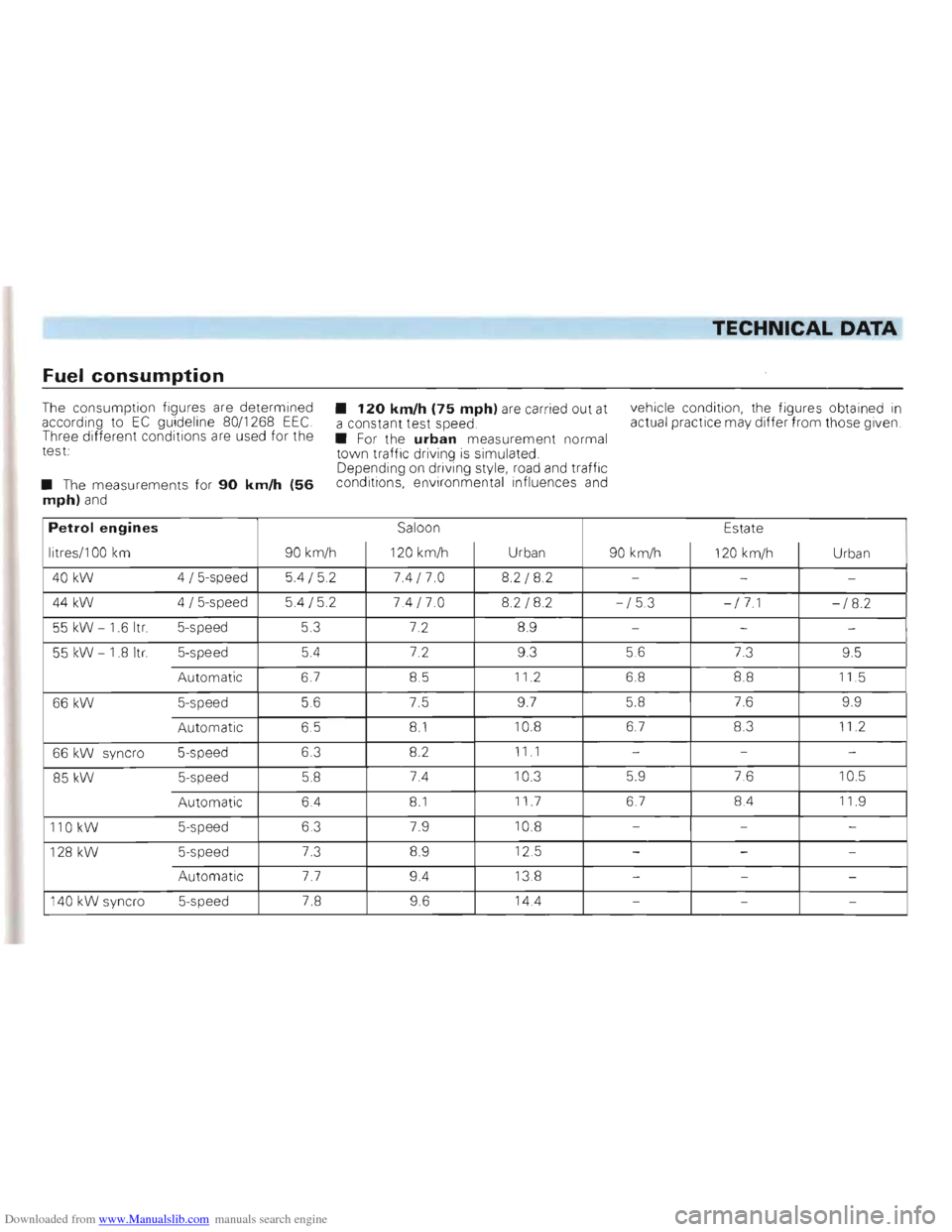
Downloaded from www.Manualslib.com manuals search engine TECHNICAL DATA
Fuel consumption
The consumption figures are determined • 120 km/h (75 mph) are carried out at vehicle
condition, the figures obtained in according to EC guideline 80/1268 EEC. a constant test speed actual
practice may differ from those given
Thre e different conditions are used for the
• For the urban measurement normal
test: town traffic driving is simulated .
Depending on driving style, road and traffic
•
The measurements for 90 km/h (56 conditions, environmental influences and
mph) and
Petrol engines
litres/lOO km 90 km/h Saloon
120 km/h Urban
90 km/h Estate
120 km/h
Urban
40 kW
4/5-speed 5.4 /5.2 7.4 /7.0 8.2/8.2 -
-
-
44 kW 4/5-speed 5.4 / 5.2
7.4 /70 8.2/8.2 -/ 5. 3 -/ 7.1 -/8 2
55 kW - 1.6 Itr. 5-speed 5.3 7.2 8.9 --
-
55 kW -1.8 ItL 5-speed
A utomatic 5.4
7.2
9.3 5
.6
7.3 9.5
6.7 8.5 11.2
6.8 8.8 11.5
66 kW 5-speed
A utomatic 5.6
7.5 9.7
5.8 7.6 9.9
6 .5
8.1 10.8 6.7 8.3 11 .2
66 kW s
y ncro 5-speed
6.3
8.2 11 . 1 ---
85 kW 5-speed
Automatic 5.8
7.4 10.3
5.9 7.6 10
.5
6.4
8.1 11 .7 6. 7 8.4 11 .
9
110 kW 5-speed 6.3
7.9 10.8
---
128
kW 5-speed
Automatic 7.3
8.9 12.5 -
--
7.7 9.4 13.8 ---
140 kW sync ro 5-speed
7.8 9.6 14.4 ---
Page 140 of 156
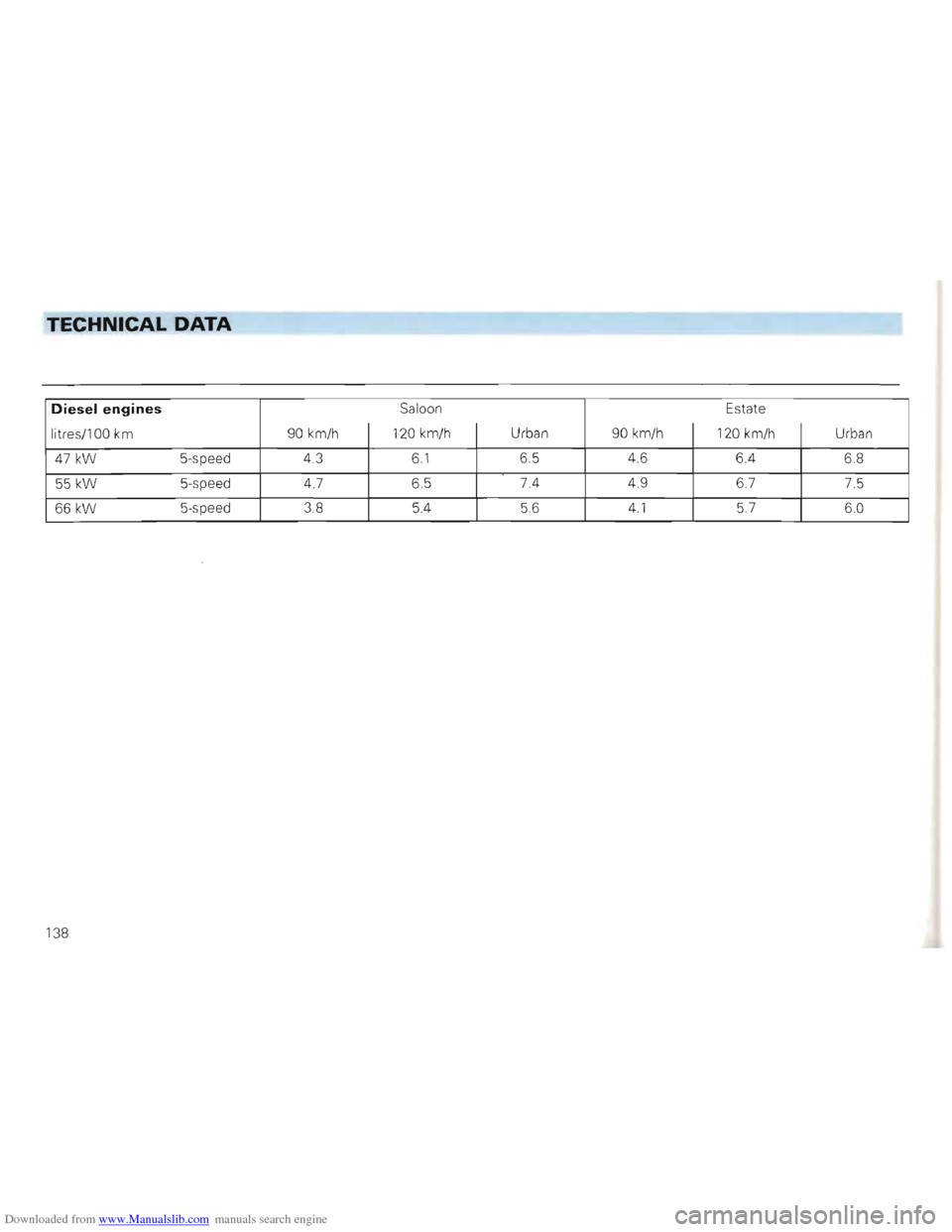
Downloaded from www.Manualslib.com manuals search engine TECHNICAL DATA
Saloon Estate Diesel engines
Urban
90 km/h 120 km/h 90 km/h 120 km/h Urban
litres!1 00 km
47
kW 5-speed 4.3 6.1 6.5 4.6 6.4 6.8
4.9
55 kW 5-speed 4.7 6.5 7.4 6.7 7.5
66
kW 5-speed 3.8 5.6 4.1
5.4 5.7 6.0
138